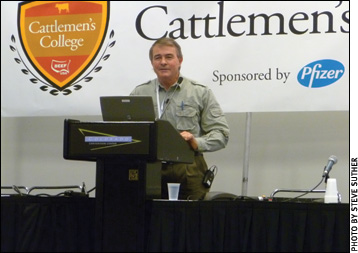Beyond AI
Specialists discuss implementation of three emerging reproductive strategies.
by Steve Suther for Certified Angus Beef LLC and Angus Productions Inc.
DENVER, Colo. (Feb. 2, 2011) — Cattlemen who already use the basics of artificial insemination (AI) learned about the next steps from three experts at Wednesday’s Cattlemen’s College.
Sexed semen
John Hall, Idaho Extension beef cattle specialist, launched into the session called “Beyond AI, Implementation of Emerging Reproductive Strategies” with a state-of-technology review of sexed semen results and economics.

Brad Stroud is a 25-year veteran in the applied field of animal Assisted Reproductive Technologies. He is a practicing veterinary cattle embryologist and is considered a visionary in his profession. He has performed more than 65,000 embryo transfers in his career.
Sorting is possible because semen carrying the female, or Y, chromosome has 3.8% more DNA, allowing a dye and electrical charge to differentiate it from material with the alternative X chromosome. Unfortunately, half of all material sorted becomes waste, which drives up the price to a range of $25-$75 per straw, Hall said.
Sexed semen can be sorted with 92% purity, and it is typically made available in ¼-inch (in.) straws rather than ½-in., containing only a little more than 10% of the sperm number as conventional product. Field trials show pregnancy rates 10-20 percentage points lower and a subsequent 20%-35% reduction in viable embryos for embryo transfer (ET) programs.
“This can still provide more embryos of the desired sex in cases where one sex is worth much more than the other,” Hall said. “Whether for AI or ET, consider this technology only if you are already getting at least average results conventionally.” Success may improve by screening females to include only cycling heifers and mature cows in good condition that have previously settled to AI, he added.
Embryo transfer
Fifty or more variables affect ET success, said John Hasler, technical consultant to Bioniche Animal Health. Regardless of continuing progress in some areas of ET, the average number of viable embryos per cow per flush remains at six, he said.
“The age of donor makes little difference from 2 to 10 years, but there are big differences between individuals,” Hasler said. Using CIDR® implants to synchronize has allowed flushing females as often as every 40 days, but again, the average number of viable embryos is still six.
Research has shown a correlation for ET success with days of the week, Tuesday netting 50.8% of ET pregnancies compared to Friday at 42.2%, Hasler said. “That shows the influence of the technician on conception rates.”
In another example, randomly splitting work that should have yielded equal results, ET technicians were told one treatment was less effective. In the end, it was a self-fulling proficy because less care was taken.
“All else being equal, the variables are individual donor, recipient and management,” Hasler concluded.
Semen quality
Veterinarian Brad Stroud has evaluated bull semen quality for 30 years in his role as a cattle embryologist at Assisted Reproductive Technologies, Weatherford, Texas. “Thermal exposure damage is an industry problem,” he said. That’s putting it mildly.
“To me, it is unbelievable, with all the thousands of ranchers who have liquid nitrogen tanks out there, managing cells and tissues, that there is no science to govern what they are doing,” Stroud said. The top factor in lower fertility with AI is mishandling of semen, he added.
Liquid nitrogen is -196° C, Stroud noted. Six inches below the neck of most tanks, the temperature is -110° C, but 2 in. below it is 12° C. It turns out that -130° C is a critical temperature for bull semen. When the temperature of frozen semen increases by those 66° (196-130 = 66), a return to -196° means rearranged, larger ice crystals.
Asking for guesses as to how long it takes the average ½-cc straw to thaw, Stroud said it is not 30 seconds, nor 50 seconds, nor 1.5 minutes, nor 3 minutes, but 3.5 minutes. “That is a bad thing,” he said.
It takes 50 seconds for a sample to reach zero motility; most samples can take no more than 30 seconds, and fertility is depressed after as little as 5 to 8 seconds out of the liquid nitrogen tank, Stroud said. “Ten seconds in the neck of a Dewar tank brings a sample to -100° C, and the ¼-cc straw is much more vulnerable to death loss from temperature,” he added.
###
Editor’s Note: The above article was written under contract or by staff of Angus Productions Inc. (API). It may not be reprinted without express permission of API. To request reprint permision, contact the editor at 816-383-5200.
www.4cattlemen.com is an event coverage site provided by the editorial team at Angus Productions Inc. (API), publisher of the Angus Journal, the Angus Beef Bulletin, the Angus Beef Bulletin EXTRA and the Angus e-List. For questions about this site, to submit an article for our consideration, or to report a broken link, contact the editor at 816-383-5200; 3201 Frederick Ave., Saint Joseph, MO 64506.
API claims copyright to this web site as presented. We welcome educational venues and cattlemen to link to this site as a service to their audience.

